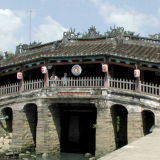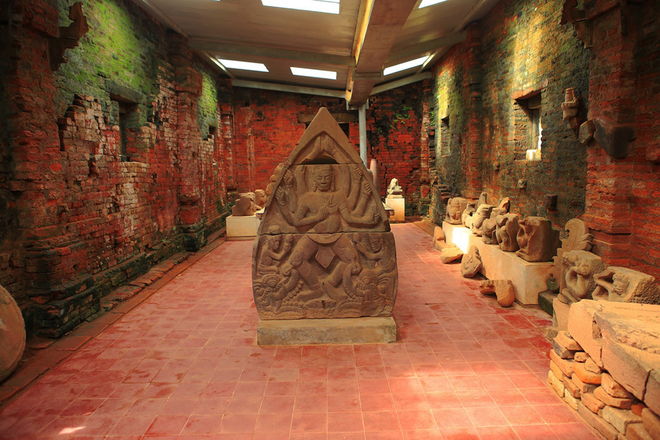Ba Ria-VT - Ba Ria - Con Dao - Vung Tau
Kien Giang - Ha Tien - Rach Gia - Phu Quoc
Thua Thien - Hue - Huong Thuy - Huong Tra
Tien Giang - My Tho - Go Cong

|
Thanh Dia My Son Duy Phu, Duy Xuyen, Quang Nam, Vietnam Last Updated: 05/22/2024 |
| Thanh Dia MY Son is an ancient archaeological site located in Quang Nam Province, Vietnam. It is a UNESCO World Heritage Site and is known for its remarkable ruins of Hindu temples and structures from the Champa civilization. It possesses 71 monuments and 32 epitaphs, the content of which is still being studied. | |
| The Cham Kingdom had two sanctuaries belonging to two main opposing clans. My Son of the Dua Clan, ruled over the north of the kingdom and was the place for the worship of God Srisana Bhadresvara. The Cau Clan, who reigned over the south had Po Nagar Sanctuary, dedicated to Goddess Po Nagar. Nevertheless, My Son was considered as the sanctuary of the Cham Kingdom. - Location: My Son is situated in a valley surrounded by mountains, about 40 kilometers southwest of Hoi An. The site is located in a lush and picturesque area. - Historical Significance: My Son was once the religious and political capital of the Champa Kingdom, which flourished from the 4th to the 14th century. The temples and structures at My Son were dedicated to various Hindu deities, primarily Shiva. - Architectural Style: The temples at My Son showcase a unique blend of indigenous Cham architectural elements and influences from Indian temple design. The structures feature intricate carvings, decorative motifs, and sculptural reliefs. - Ruins: Over the centuries, the site has faced the impacts of time, weather, and conflicts, including the Vietnam War. Many of the structures were damaged or destroyed, but significant restoration efforts have been made to preserve and protect the remaining ruins. - Sacredness: My Son was a significant religious and cultural center for the Champa people. The temples served as places of worship, rituals, and ceremonies, reflecting the religious beliefs and practices of the Champa Kingdom. - Architecture and Layout: The site features multiple temple complexes with various structures, including towers, sanctuaries, and plinths. The architectural layout of My Son follows specific design principles and orientations. - UNESCO World Heritage Site: My Son was designated as a UNESCO World Heritage Site in 1999, recognizing its cultural and historical significance as well as its architectural importance. - Guided Tours: Visitors to My Son can explore the site through guided tours that provide historical context and insights into the Champa civilization and its religious practices. - Conservation and Preservation: Ongoing efforts are made to maintain and protect the remaining structures at My Son. The restoration work aims to balance the preservation of historical authenticity with necessary conservation measures. - Access: My Son is accessible from Hoi An, Da Nang, and other nearby locations. Guided tours and transportation services are available for those wishing to visit the site. Visiting My Son offers a glimpse into the historical and cultural heritage of the Champa Kingdom and its influence on the region. | |
Wikipedia
Vietnam » Quang Nam
Place » Historical Place

|
Thap Bang An Place » Historical Place Bằng An Tower is a historical site located in Quảng Nam. The tower is an ancient Cham temple, built around the 9th to 10th centuries during the Champa Kingdom's rule. The architecture is notable for its octagonal structure. Made of bricks, it was originally a Hindu temple dedicated to Lord Shiva, reflecting the Cham people's religious and cultural practices at the time. 22 views 💖 1Điện An, Điện Bàn, Quảng Nam, Vietnam |

|
Dinh Lang Thanh Chiem Place » Historical Place Dinh trấn Thanh Chiêm (Đình Làng Thanh Chiêm), located in Điện Phương, Điện Bàn, Quảng Nam, Vietnam, was an important administrative and military base during the Nguyễn Lords' rule in the 16th and 17th centuries. It was one of the main administrative centers in the central region of Vietnam, playing a crucial role in managing the southern expansion and controlling the area. 17 views 💖 1Điện Phương, Điện Bàn, Quảng Nam, Vietnam |

|
Quang Nam Place » City Quang Nam is a province in the Central region of Vietnam. It is bordered by Thua Thien-Hue province to the north, the nation of Laos to the west, Kon Tum province to the southwest, Quang Ngai province to the southeast, the East Sea to the east, and the city of Da Nang to the northeast. It had a population of 1,945,812 In 2021. 70 views 💖 1Vietnam |

|
Chua Cau Hoi An Place » Historical Place Chua Cau Hoi An, also known as Japanese Covered Bridge or Lai Vien Kieu, is an ancient bridge in the ancient town of Hoi An, Quang Nam province, Vietnam. This bridge was built by Japanese merchants around the 17th century, so it is sometimes called the Japanese bridge. 331 views 💖 1186 Tran Phu, Phuong Minh An, Hoi An, Quang Nam |

|
Thap Cham Khuong My Place » Historical Place Thap Cham Khuong My, also known as Khuong My Towers, is agroup of Cham towers located in Nui Thanh District, Quang Nam Province, Vietnam. These ancient towers are remnants of the Cham civilization and provide insight into the cultural and historical heritage of the region. 361 views 💖 3Lien xa, Nui Thanh, Quang Nam, Vietnam |

|
Pho Co Hoi An Place » Historical Place Pho co Hoi An, or Hoi An Ancient Town, is a charming and well-preserved historic riverside town located in Hoi An, Quang Nam Province, Vietnam. It is renowned for its unique blend of architectural styles, cultural heritage, vibrant atmosphere and its history as a merchant trading post. 347 views 💖 3Le Loi, Minh An, Hoi An, Quang Nam, Vietnam |
